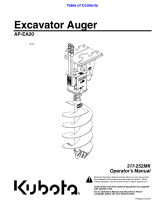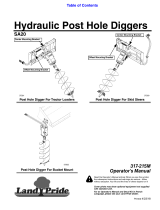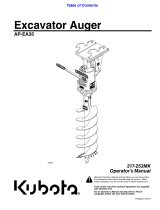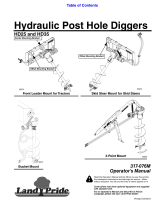Page is loading ...

Operator’s Manual
English (CE)
FORM NO. 3322–612
Auger
Sitework Systems Attachment
Model No. 22400 – 80001 & Up

2
The Toro Company – 1999
8111 Lyndale Ave. South
Bloomington, MN 55420–1196
All Rights Reserved
Printed in the USA
Contents
Page
Introduction 2.
. . . . . . . . . . . . . . . . . . . . . . . . . . . . . . . .
Safety 2
. . . . . . . . . . . . . . . . . . . . . . . . . . . . . . . . . . . . . .
Safety Decals
3
. . . . . . . . . . . . . . . . . . . . . . . . . . . . .
Specifications 3
. . . . . . . . . . . . . . . . . . . . . . . . . . . . . . . .
Stability Ratings
4
. . . . . . . . . . . . . . . . . . . . . . . . . . .
Installation 5
. . . . . . . . . . . . . . . . . . . . . . . . . . . . . . . . . .
Loose/Separate/Optional Parts
5
. . . . . . . . . . . . . . . .
Installing the Drive Head on the T
raction Unit
5
. . .
Connecting the Hydraulic Hoses
6
. . . . . . . . . . . . . .
Installing an Auger onto the Drive Head
6
. . . . . . . .
Removing an Auger/Extension from the
Drive Head
7
. . . . . . . . . . . . . . . . . . . . . . . . . . . . .
Removing the Drive Head from the T
raction Unit
7
Operation 8
. . . . . . . . . . . . . . . . . . . . . . . . . . . . . . . . . . .
Digging a Hole
8
. . . . . . . . . . . . . . . . . . . . . . . . . . . .
Maintenance 8
. . . . . . . . . . . . . . . . . . . . . . . . . . . . . . . . .
Service Interval Chart
8
. . . . . . . . . . . . . . . . . . . . . .
Checking Planetary Gear Case Oil
9
. . . . . . . . . . . . .
Changing Planetary Gear Case Oil
9
. . . . . . . . . . . .
Storage 9
. . . . . . . . . . . . . . . . . . . . . . . . . . . . . . . . . .
Troubleshooting 10
. . . . . . . . . . . . . . . . . . . . . . . . . . . . . .
Introduction
W
e want you to be completely satisfied with your new
product, so feel free to contact your local Authorized
Service Dealer for help with service, genuine replacement
parts, or other information you may require.
Whenever you contact your Authorized Service Dealer or
the factory
, always know the model and serial numbers of
your product. These numbers will help the Service Dealer
or Service Representative provide exact information about
your specific product. Y
ou will find the model and serial
number on a plate located on the auger drive head. On
augers and extensions, the model and serial number plate
is located on the upper portion of the shaft.
For your convenience, write the product model and serial
numbers in the space below
.
Model No:
Serial No.
The
warning system in this manual identifies potential
hazards and has special safety messages that help you and
others avoid personal injury
, even death. DANGER,
W
ARNING and CAUTION are signal words used to
identify the level of hazard. However
, regardless of the
hazard, be extremely careful.
DANGER
signals an extreme hazard that will cause
serious injury or death if the recommended precautions
are not followed.
WARNING
signals a hazard that may cause serious injury
or death if the recommended precautions are not followed.
CAUTION
signals a hazard that may cause minor or
moderate injury if the recommended precautions are not
followed.
T
wo other words are also used to highlight information.
“Important” calls attention to special mechanical
information and “Note” emphasizes general information
worthy of special attention.
The left and right side of the machine is determined by
sitting on the seat in the normal operator
’
s position.
Safety
Impr
oper use or maintenance by the operator or owner
can r
esult in injury
. T
o r
educe the potential for injury
,
comply with these safety instructions and those in the
traction unit operator
’
s manual. Always pay attention
to the safety alert
symbol, which means CAUTION,
W
ARNING, or DANGER—“personal safety
instruction.” Failur
e to comply with the instruction
may r
esult in personal injury or death.
DANGER
POTENTIAL HAZARD
•
Contact with a moving auger can cause
entanglement, sever
e wounds, and/or death.
WHA
T CAN HAPPEN
•
Entangled arms and legs may be cut off or
br
oken. Death may r
esult.
HOW T
O A
V
OID THE HAZARD
•
Keep all others at least 10 feet away fr
om the
auger during operation. Also, do not r
eplace
the supplied bolt which secur
es the auger to the
drive head with a longer bolt as this may
incr
ease the chance for entanglement.

3
DANGER
POTENTIAL HAZARD
• Ther
e may be buried power
, gas, and/or
telephone lines in the work ar
ea.
WHA
T CAN HAPPEN
•
Shock or explosion may occur
.
HOW T
O A
V
OID THE HAZARD
•
Have the pr
operty or work ar
ea marked for
buried lines and do not dig in marked ar
eas.
WARNING
POTENTIAL HAZARD
•
When going up or down hill, the machine could
overturn if the heavy end is toward the
downhill side.
WHA
T CAN HAPPEN
•
Someone may be pinned or seriously injured by
the machine if it overturns.
HOW T
O A
V
OID THE HAZARD
•
Operate up and down slopes with the heavy end
of the machine uphill. An attached auger bit
will make the fr
ont end heavy
.
WARNING
POTENTIAL HAZARD
•
When the engine is off, attachments in the
raised position can gradually lower
.
WHA
T CAN HAPPEN
•
Someone nearby may be pinned or injur
ed by
the attachment as it lowers.
HOW T
O A
V
OID THE HAZARD
•
Always lower the attachment lift each time you
shut off the traction unit.
Safety
Decals
#
99–9942
1
2
3
5
6
7
4
Figure 1
1. Safety
alert symbol
2.
Read operator
’
s manual
3.
Full body entanglement
4.
Stay away from rotating
shafts and augers
5.
Explosion hazard
6.
Electric shock hazard
7.
Do not dig in areas with
buried gas or power lines
Specifications
Note:
Specifications and design are subject to change without notice.
Width 16
inches (40.64 cm)
Length
24 inches (60.96 cm)
Height
22 inches (55.88 cm)
W
eight (without auger)
176 lbs (79.8 Kg)
Maximum auger diameter
30 inches (76.2 cm)
Motor
Displacement
Rated pressure
Flow range
1
1.9 in
3
/rev (28.93 cm
3
/rev)
3000 PSI Continuous (21
1 Kg/cm
2
)
0–20 GPM (38–76 Lpm)
Drive ratio
3.75:1
Output shaft diameter
2.56 inches (6.5 cm)

4
Stability
Ratings
To
determine the degree of slope you can traverse with the auger installed on a traction unit, find the stability rating for the
hill position you want to travel in the appropriate table below
, then find the degree of slope for the same rating and hill
position in the Stability Data section of the traction unit operator
’
s manual.
WARNING
POTENTIAL HAZARD
•
Exceeding the maximum slope can cause the traction unit to tip.
WHA
T CAN HAPPEN
•
If the traction unit tips, you or bystanders could be crushed.
HOW T
O A
V
OID THE HAZARD
•
Do not drive the traction unit on a slope steeper than the maximum slope.
Stability With a 30 inch Auger
Orientation
Stability Rating
Front Uphill
C
Rear Uphill
D
Side Uphill
C
IMPORTANT:
The auger drive head with a large
auger installed is rated for use with the counterweight.
Do not use it with a large auger without the
counterweight or the traction unit will become
unstable.
Stability Without an Auger
Orientation
Stability Rating
Front Uphill
D
Rear Uphill
C
Side Uphill
B
Note:
The auger drive head without an auger is rated for
use without the counterweight. If you use the
counterweight, the traction unit will be less stable in the
front and side uphill positions.
Stability With Augers Less Than 30
inches in Diameter
Augers
smaller than 30 inches in diameter will have
stabilities between the stability of the drive head alone
and the drive head with the 30 inch auger
. Augers above
12 inches will have a stability closer to the 30 inch auger
and should be used with the counterweight. Augers
smaller than 12 inches will have a stability closer to the
drive head alone and should be used without the
counterweight.

5
Installation
Loose/Separate/Optional
Parts
DESCRIPTION QTY. USE
Auger
drive head
1
Install on traction unit
Auger (any size, sold separately)
Bolt, 7/8”–9 x 4–1/2”
Nut, 7/8”–9
Bolt, 5/8”–1
1 x 3–1/2”
Nut, 5/8”–1
1
1
1
1
2
2
Install auger on drive head
Auger extension (sold separately)
Bolt, 7/8”–9 x 4–1/2”
Nut, 7/8”–9
1
1
1
Install between drive head and auger
Rear stabilizer (sold separately)
1
Recommended for use with small diameter
augers
Counterweight (sold separately)
1
Required for use with large diameter augers
Installing
the Drive Head on
the T
raction Unit
IMPORTANT:
Befor
e installing, ensur
e that the mount
plates ar
e fr
ee of any dirt or debris.
Note:
Always use the traction unit to lift and move the
drive head. T
o move an auger without the drive head,
sling a strap over each end of the auger and hoist it to the
desired location.
1.
Ensure that the drive head is positioned on a level
surface with enough space behind it to accommodate
the traction unit.
2.
Move the pump control lever to the slow (turtle)
position the start the engine.
3.
Slowly push the attachment tilt lever forward to tilt the
mount plate forward.
4.
Position the mount plate into the upper lip of the
receiver plate on the drive head (Fig. 2).
m–4055
1
2
Figure
2
1. Mount
plate
2.
Receiver plate
5. Raise
the loader arms while tilting back the mount
plate at the same time.
IMPORTANT
: The drive head should be raised enough
to clear the gr
ound and the mount plate should be
tilted all the way back.
6.
Stop the engine.
7.
Engage the quick attach pins (Fig. 3).

6
m–4056
1
Figure
3
1. Quick
attach pins (shown in engaged position)
Connecting
the Hydraulic
Hoses
WARNING
POTENTIAL
HAZARD
• Hydraulic fluid escaping under pressure
can penetrate skin and cause injury.
WHAT
CAN HAPPEN
• Fluid accidentally injected into the skin
must be surgically removed within a few
hours by a doctor familiar with this form of
injury or gangrene may result.
HOW
T
O A
V
OID THE HAZARD
• Keep body and hands away from pin hole
leaks or nozzles that eject high pressure
hydraulic fluid.
• Use cardboard or paper to find hydraulic
leaks, never use your hands.
1. Stop
the engine.
2.
Move the auxiliary hydraulic lever forward, backward,
and back to neutral position to relieve hydraulic
pressure at the hydraulic couplers.
IMPORTANT
: Ensur
e that all for
eign matter is
cleaned fr
om hydraulic connections befor
e making
connections.
3.
Remove the protective covers from the hydraulic
couplers on the traction unit.
4.
Connect the covers together to prevent contamination
during operation.
5.
Slide the collar back on the hydraulic coupler and
connect the attachment couplers to the traction unit
couplers.
6.
Confirm that the connection is secure by pulling on the
hoses.
Installing
an Auger onto the
Drive Head
WARNING
POTENTIAL
HAZARD
•
The auger head swings fr
eely in the cradle
arms.
WHA
T CAN HAPPEN
•
Hands or fingers could get pinched and sever
ely
injur
ed or amputated if they ar
e caught
between the cradle arms and the swinging drive
head.
HOW T
O A
V
OID THE HAZARD
•
Keep hands and fingers away fr
om the cradle
arms.
1.
Raise the loader arms so the drive head clears the
ground.
2.
Stop the engine.
3.
Manually rotate the auger drive head up, until you can
slide (2) 5/8”–1
1 x 3–1/2” bolts into the holes on both
sides of the cradle arms, securing the drive head.
Lightly secure each bolt with a 5/8”–1
1 nut (Fig. 4).
m–3944
1
2
3
Figure
4
1. Drive
head
2.
Cradle arm
3.
Bolts (5/8”–11 x 3–1/2”)
and nuts (5/8”–1
1)
4. If
using an extension with the auger
, insert the end of
the extension into the end of the auger and secure the
auger to the drive head with the 7/8”–9 x 4–1/2” bolt
and 7/8”–1
1 nut (Fig. 5).

7
m–3971
1
2
4
3
Figure
5
1. Extension
2. Auger
shaft
3.
Bolt (7/8”–9 x 4–1/2”)
4.
Nut (7/8”–9)
5. Start
the engine.
6.
Maneuver the drive shaft into the end of the auger
shaft or extension (if applicable) (Fig. 6).
m–3945
1
2
Figure
6
1. Drive
head
2.
Auger shaft
7. Stop
the engine.
8.
Secure the auger to the drive head with the 7/8”–9 x
4–1/2” bolt and 7/8”–1
1 nut (Fig. 7).
9.
Remove the bolts and nuts from the cradle arms that
were installed in step 3 (Fig. 7).
m–3946
2
1
3
Figure
7
1. Bolt
(7/8”–9 x 4–1/2”)
2.
Nut (7/8”–9)
3.
Bolts (5/8”–11 x 3–1/2”)
and nuts (5/8”–1
1)
10.Start
the engine.
11.
Raise the auger free of the ground (Fig. 8).
12.
When the auger is vertical, tilt the attachment plate
rearward, until the drive head contacts the attachment
plate to stabilize the auger and keep it from swinging
freely (Fig. 8).
m–3948
Figure
8
Removing
an Auger/Extension
from the Drive Head
1. Raise
the loader arms so the auger comes out of the
hole.
Note:
If you have a 24 inch extension installed between
the drive head and the auger
, it may be necessary to raise
the auger as high as possible and then move the traction
unit backward to pull the auger the rest of the way out of
the hole.
2.
Set the auger down in its storage location.
3.
While lowering the arms, drive slowly backwards until
the auger is horizontal.
4.
Stop the engine.
5.
Remove the bolt and nut securing the drive head to the
auger or extension.
6.
Start the engine and back the traction unit away from
the auger
.
7.
If an extension was used, remove the bolt securing it
and pull it of
f of the auger
.
Removing
the Drive Head from
the T
raction Unit
1. Start
the engine and lower the drive head to the ground
or onto a trailer
.
2.
Stop the engine.
3.
Disengage the quick attach pins by turning them to the
outside.

8
4.
Slide the collars back on the hydraulic couplers and
disconnect them.
IMPORTANT
: Connect the attachment hoses together
to pr
event hydraulic system contamination during
storage.
5.
Install the protective covers onto the hydraulic
couplers on the traction unit.
6.
Start the engine, tilt the mount plate forward, and back
the traction unit away from the drive head.
Operation
Digging
a Hole
DANGER
POTENTIAL
HAZARD
• Ther
e may be buried power
, gas, and/or
telephone lines in the work ar
ea.
WHA
T CAN HAPPEN
•
Shock or explosion may occur
.
HOW T
O A
V
OID THE HAZARD
•
Have the pr
operty or work ar
ea marked for
buried lines and do not dig in marked ar
eas.
IMPORTANT
: Befor
e digging, ensur
e that the gr
ound
is fr
ee of any trash or debris.
IMPORTANT
: Do not use the auger unless the auger
point and teeth ar
e intact and in good condition.
1.
Lower the auger to the soil at the site of the proposed
hole.
2.
Move the throttle lever to fast (rabbit), the pump
selector lever to slow (turtle), and the flow divider
control dial to the 10:00 o’clock position.
3.
Pull the auxiliary hydraulics lever backward to begin
drilling.
4.
Lower the auger slowly as the soil is loosened. As you
dig deeper
, move the traction unit backward or forward
as required to keep the hole vertical (Fig. 9).
m–3951
m–3950
Figure
9
5. When
the auger becomes full of soil, disengage the
auger drive and lift the auger from the hole. Engage
the auger drive to spin of
f the soil, then resume
digging.
Note:
Switching rapidly from forward to reverse will help
to shake of
f the soil.
Maintenance
Service
Interval Chart
Service
Operation
Each
Use
25
Hours
50
Hours
1000
Hours
Storage
Service
Notes
Auger teeth–inspect
X X
Replace if damaged
or worn
Planetary gear case oil–check
X
Planetary gear case oil–change
X
Chipped surfaces—paint
X

9
CAUTION
POTENTIAL
HAZARD
•
If you leave the key in the ignition switch, someone could start the engine.
WHA
T CAN HAPPEN
•
Accidental starting of the engine could seriously injur
e you or other bystanders.
HOW T
O A
V
OID THE HAZARD
•
Remove the key fr
om the ignition switch befor
e you do any maintenance.
Checking
Planetary Gear Case
Oil
Check
the oil level in the planetary gear case every 25
hours and top of
f the oil if necessary
.
1.
Place the auger drive head on the ground so that the
drive shaft is parallel with the ground.
2.
Rotate the drive head so that the oil drain plug is
located on top and the breather plug is on the bottom
(Fig. 10).
3.
Remove the oil drain plug (Fig. 10)
4.
Rotate the auger drive head so that the drain opening is
at the 2 o’clock position (Fig 10). Oil should just
begin to come out of the opening.
m–4054
1
2
Figure
10
1. Drain
plug
2.
Breather plug
5. If
no oil comes out of the opening, add oil (a mild,
extreme pressure lubricant API–GL–5, number 80 or
90) until the oil starts to run out when the drain hole is
at the 2 o’clock position.
6.
Replace the drain plug.
Changing
Planetary Gear Case
Oil
Change
the oil after the first 50 hours of operation and
every 1000 hours thereafter
. The planetary gear case
requires 2 pints of a mild, extreme pressure lubricant,
rated API–GL–5, number 80 or 90.
1.
Support the drive head over an oil pan so that the oil
drain plug (Fig. 10) is on the bottom of the drive head,
facing the oil pan.
2.
Remove the oil drain plug to drain the oil.
3.
When the oil is completely drained, turn the drive
head so that the oil drain opening is on the top of the
drive head, facing the up.
4.
Add 2 pints of a mild, extreme pressure lubricant,
rated API–GL–5, number 80 or 90.
5.
Replace the drain plug.
Storage
1.
Before long term storage, wash the attachment with
mild deter
gent and water
.
2.
Check and tighten all bolts, nuts, and screws. Repair or
replace any damaged or worn part.
3.
Ensure that all hydraulic couplers are connected
together to prevent contamination of the hydraulic
system.
4.
Paint all scratched or bare metal surfaces. Paint is
available from your Authorized Service Dealer
.
5.
Store the attachment in a clean, dry garage or storage
area. Cover it to protect it and keep it clean.

10
Troubleshooting
PROBLEM POSSIBLE
CAUSES
CORRECTIVE ACTION
Drive head does not operate.
1.
Hydraulic coupler not
completely connected
1.
Check and tighten all couplers.
2.
Defective hydraulic coupler
2.
Check couplers and replace
any that are defective.
3.
An obstruction in a hydraulic
hose
3.
Find and remove the
obstruction.
4.
Kinked hydraulic hose
4.
Replace the kinked hose
5.
Contamination in the gearbox
5.
Refer to your authorized
service dealer
.

11

/





